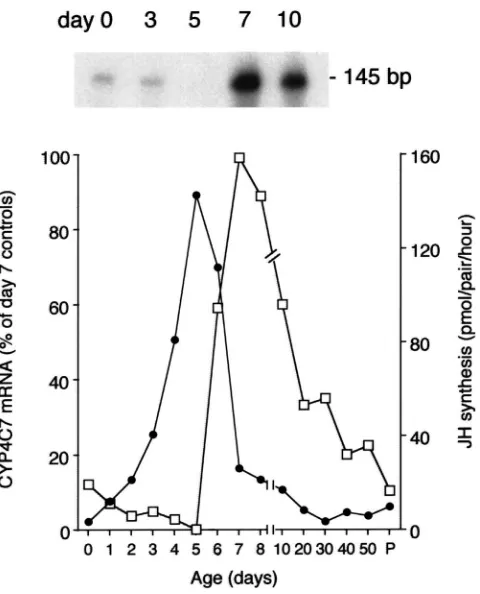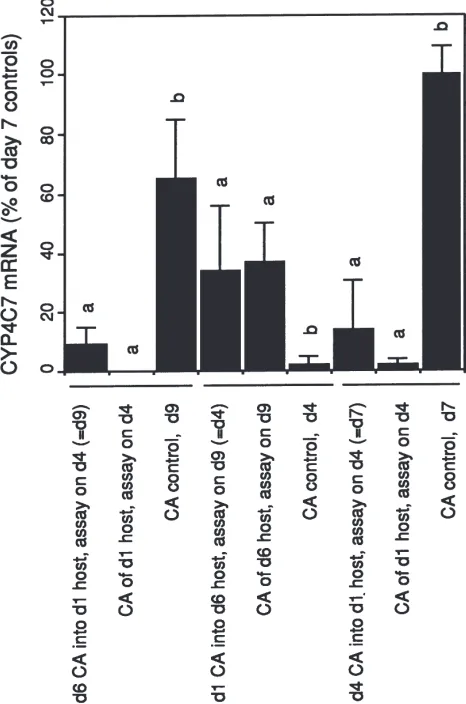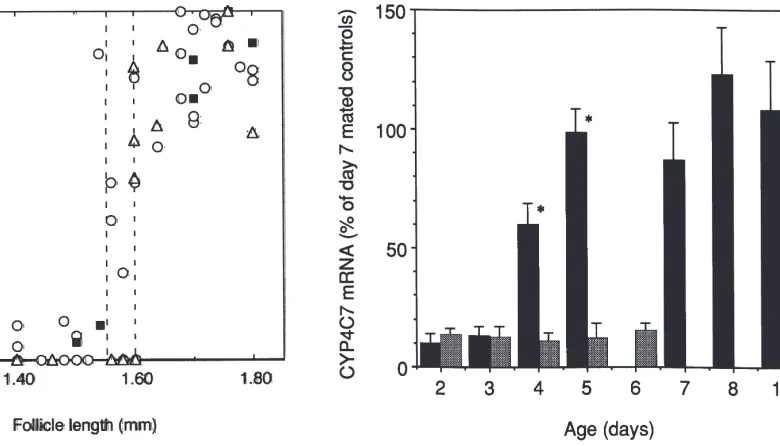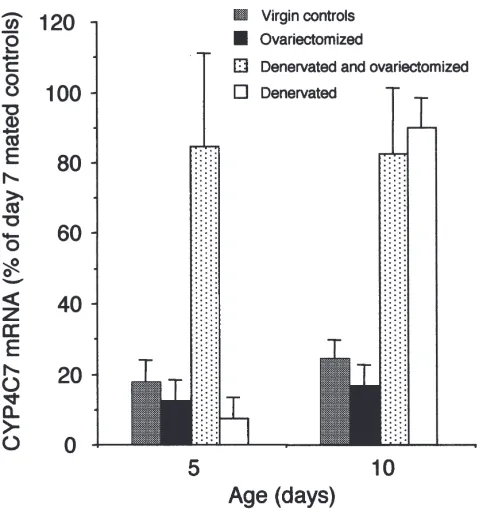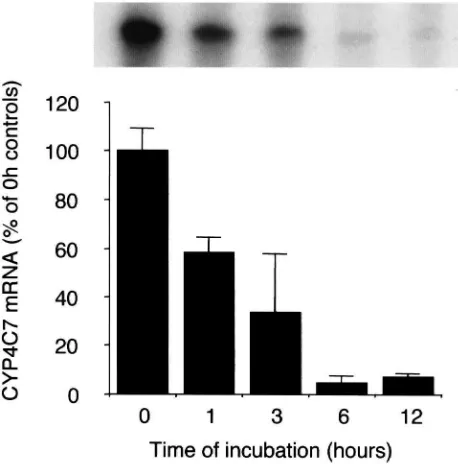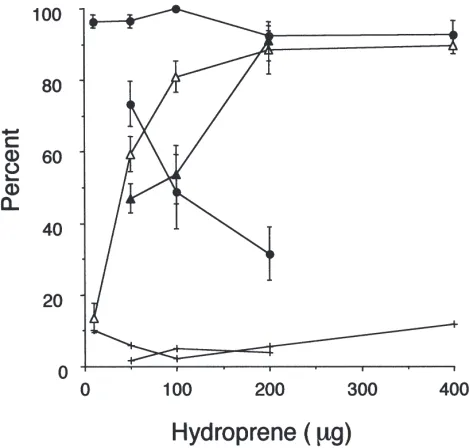www.elsevier.com/locate/jinsphys
Terpenoid
ω
-hydroxylase (CYP4C7) messenger RNA levels in the
corpora allata: a marker for ovarian control of juvenile hormone
synthesis in Diploptera punctata
Tara D. Sutherland
1, Gopalan C. Unnithan, Rene´ Feyereisen
*Department of Entomology, The University of Arizona, Forbes 410, PO Box 210036, Tucson, AZ 85721-0036, USA
Received 18 October 1999; accepted 12 January 2000
Abstract
Ribonuclease protection assays were used to measure changes in allatal transcript levels of the CYP4C7 gene which encodes a cytochrome P450 terpenoidω-hydroxylase thought to play a role in the metabolism of JH and its precursors. Denervation of the corpora allata does not affect the pattern of expression of the CYP4C7 gene. Transplantation experiments show that CYP4C7 mRNA levels are dependent on a humoral factor characteristic of the reproductive state of the insect. Messenger RNA levels rise substantially in mated or denervated females, or in mated or virgin females treated with hydroprene, when the follicle length is over 1.5 mm. Vitellogenic ovaries however exert a negative influence on CYP4C7 expression, as ovariectomy in mated females causes a premature rise in CYP4C7 mRNA levels. The half-life of the CYP4C7 transcript is approx. 2 h when the corpora allata are incubated in vitro. Under these conditions, coincubation with a post-vitellogenic ovary maintains high CYP4C7 transcript levels in the glands. Excess juvenile hormone or analog applied at the end of vitellogenesis blocks ovulation or causes abortion of embryos deposited in the brood sac. We conclude that expression of the CYP4C7 gene is tightly controlled by the ovary, and it coincides with the ovarian signal to turn off juvenile hormone synthesis. The role of the CYP4C7 enzyme may be to ensure the clearance of allatal juvenile hormone and its precursors at the end of the gonotrophic cycle.2000 Elsevier Science Ltd. All rights reserved.
Keywords: Cockroach; CYP4C7; Cytochrome P450; Ribonuclease protection assay; Ovary
1. Introduction
The role of juvenile hormone (JH) in reproduction is well established but the precise molecular mechanisms controlling the endocrine activity of the corpora allata (CA) are still poorly understood. Physiological experi-ments linked to short-term assays for CA activity in vitro have revealed that both neural and humoral signals are involved (Feyereisen, 1985). The reproductive cycle of the cockroach, Diploptera punctata has served as a con-venient model system because of its well defined cycles of CA activity that are linked to the specialized mode of reproduction of this species—viviparity. The develop-mental state of the basal oocytes appear to play a major
* Corresponding author. Tel.:+1-520-621-9598; fax:+ 1-520-626-8058.
E-mail address: [email protected] (R. Feyereisen). 1 Present address: CSIRO, Division of Biotechnology, Canberra,
ACT, Australia
0022-1910/00/$ - see front matter2000 Elsevier Science Ltd. All rights reserved. PII: S 0 0 2 2 - 1 9 1 0 ( 0 0 ) 0 0 0 4 2 - 1
role in regulating CA activity in D. punctata. Basal oocytes in rapid vitellogenesis stimulate JH production (Stay et al., 1983; Rankin and Stay, 1984) whereas those near maturity are inhibitory (Rankin and Stay, 1985). Allatostatins, isolated from the brain of D. punctata and found in the CA and neural connections to the brain, are short term, reversible inhibitors of JH synthesis (Stay et al., 1994). The sensitivity of the CA to allatostatins is tightly regulated during the reproductive cycle (Pratt et al., 1990) and acquisition of allatostatin sensitivity by the CA is determined by the endocrine milieu (Unnithan and Feyereisen, 1995). Whilst the in vitro assays of JH synthesis have been extremely useful, the study of CA regulation during the reproductive cycle has been ham-pered by the lack of more specific molecular tools. We have recently reported the cloning and functional expression of a cytochrome P450 expressed in the CA,
CYP4C7, that metabolizes JH and JH precursors byω
females (Sutherland et al., 1998). Levels are low from the day of adult emergence and mating (day 0) to day 5 when JH synthesis is at a peak. However, one day later (day 6) CYP4C7 mRNA levels increase and then reach a maximum on day 7 just before oviposition. Levels of CYP4C7 mRNA decrease gradually during pregnancy, and are back to day 0 levels at parturition, when a new cycle of JH synthesis begins (Sutherland et al., 1998). We now report that monitoring changes in mRNA levels for this P450 is a sensitive molecular tool for the study of CA regulation. The RNase protection assay (RPA) provides a sensitive and reliable system to measure responses of CYP4C7 mRNA levels to physiological manipulation, including the effects of nerve section, the endocrine milieu, the ovary, and JH analogue on
CYP4C7 expression.
2. Materials and methods
2.1. Insects
Diploptera punctata were reared as described
pre-viously (Meller et al., 1985). Virgin females were col-lected from cages free of adult males. Mated females were collected within 4 h of molting and mated status was confirmed by the presence of a spermatophore. Transplantation was performed as previously described (Unnithan and Feyereisen, 1995). For denervation of the CA, corpora cardiaca (CC) and CA of insects chilled on ice were exposed by cutting the neck membrane and the attached part of the head capsule. Connection of the CA to the brain was severed in front of the CC with fine forceps. The wound was closed with the cut portion of the head capsule, and streptomycin powder was sprinkled on the surface of the wound. Mortality after this surgery was negligible. Hydroprene (ZR512)
treat-ment was performed by topically applying 200µg of the
compound dissolved in 2 µl acetone, to the ventral side
of the thorax of one-day-old insects. Control insects
were treated with 2µl acetone. The imidazole compound
TH27 (100 µg in 2µl acetone) was topically applied to
three-day-old mated females, which were assayed 24 h later. Control insects were treated with acetone. 20-hyd-roxyecdysone treatment was performed by injecting
two-day-old mated females with 5 µg hormone dissolved in
3 µl 80% tissue culture medium M199/20% ethanol.
Injections were repeated 24 and 48 h later. Control
insects were injected with 3 µl 80% tissue culture
medium M199/20% ethanol.
2.2. Assays
Levels of JH synthesis were determined by the radi-ochemical assay for incorporation of label from
[methyl-3
H]methionine into juvenile hormone III as modified
(Pratt et al., 1990). The RNase protection assay (RPA) for measuring CYP4C7 mRNA levels on single pairs of CA was performed as described previously (Sutherland et al., 1998). In all our experiments, RNA from glands of day 7 mated females (eggs after chorionation but before ovulation) serve as the arbitrary 100% control value for relative levels of CYP4C7 mRNA.
3. Results
3.1. Effect of CA denervation
We have measured the transcript levels for the
CYP4C7 gene by ribonuclease protection assays
perfor-med on lysates from single gland pairs (Fig. 1). This gene is expressed within the CA during periods of intrin-sic repression of JH synthesis (Fig. 1) (Sutherland et al., 1998). To understand the physiological mechanism underlying this pattern of change, we first studied the effect of severing the nervous connections between the brain and the CA. Gland denervation does not alter the pattern of JH synthesis in mated females (Stay and Tobe,
1977). When we denervated the CA on day 6 and assayed on day 8, the relative level of mRNA was 97±12% (n=3) compared to 88±14% (n=3) in the sham-operated controls, and when we denervated on day 4 and assayed on day 7 the treated insects had relative levels
of message of 46±12% (n=3) compared to the controls
which had 59±13% (n=3). The process of surgery
invariably delays development and this presumably led to levels of CYP4C7 mRNA more typical of day 6 than of normal day 7 levels in both sham-operated and dener-vated animals. However these levels are significantly higher than those of day 4 (Sutherland et al., 1998). Thus denervation of the CA in six-day-old mated females did not cause a decrease in the high levels of CYP4C7 mRNA, and denervation in four-day-old mated insects did not prevent the subsequent increase in CYP4C7 message.
3.2. Effect of the endocrine milieu: CA transplantation
These results of in situ denervation experiments allowed us to study the effect of the endocrine milieu by transplanting CA from mated females forward or backwards during the cycle of JH synthesis (Fig. 2). The CA of females of day 6 (just after spermatophore release) have high levels of CYP4C7 mRNA which peak on day 7 then decline to 65% after three days (day 9). When these glands were transplanted into day 1 hosts and assayed three days later they showed only low CYP4C7 mRNA levels (9%). On the other hand CA from day 1 females, which have low levels of CYP4C7 expression, showed 34% expression when transplanted into day 4 hosts and assayed three days later. Glands from day 4 females had low levels of CYP4C7 mRNA three days after transplantation into a day 1 host, in con-trast to the high levels expected if they had remained for three days in the donor endocrine environment. In all cases the transplanted glands assumed levels of CYP4C7 mRNA more closely resembling the gland from the host than levels of message normally associated with their developmental stage (Fig. 2). Thus, CYP4C7 mRNA levels in the CA are not dependent on either innervation or the intrinsic developmental age of the gland, but on a humoral factor characteristic of the reproductive state of the insect.
3.3. Correlation of CYP4C7 messenger RNA levels with physiological events
As shown earlier (Sutherland et al., 1998), CYP4C7 mRNA levels are undetectable on day 5, and almost half-maximal one day later. A more precise correlation of CYP4C7 mRNA levels and the length of the terminal follicle in a series of mated females analyzed between days 5 and 7 revealed that this increase occurs after the follicles have reached 1.5 mm in length (Fig. 3). Little
Fig. 2. Levels of CYP4C7 mRNA in CA transplanted into hosts of different ages. The amount of CYP4C7 mRNA is expressed as the % of the average maximal level found in day 7 mated insects. The age of the transplanted CA and the age of the host at transplantation are shown. Days in parenteses indicate the age of the transplanted CA when assayed. Each bar represents the mean and standard deviation of three to five assays. In each series, indicated with a verical line, bars marked by the same letter are not statistically different from each other.
or no message was observed in the CA of animals prior to this developmental stage, which is characterized by allatostatin insensitivity (Pratt et al., 1990) and message levels were high in all animals with primary follicles over 1.7 mm in length. These older animals are allatosta-tin-sensitive (Pratt et al., 1990). Intermediate levels of message were observed in animals with follicles between 1.55 mm and 1.60 mm in length, which corresponds to the period of transition from allatostatin insensitivity to allatostatin sensitivity (Pratt et al., 1990).
3.4. Effect of topical application of JH analog on CYP4C7 messenger RNA levels
Fig. 3. Correlation between the level of CYP4C7 mRNA and follicle size in individual mated females with (g) or without (s) hydroprene treatment and in hydroprene-treated virgins (j), five to seven days after treatment. Treatment was performed by topically applying 200 µg hydroprene in 2µl acetone to the ventral side of day 1 insects. The amount of CYP4C7 mRNA is expressed as % of the average maximal level found in day 7 mated insects. Each point represents a single animal. The two stippled vertical lines indicates follicles lengths below which the CA are allatostatin-insensitive and above which the CA are allatostatin sensitive (see Pratt et al., 1990).
CYP4C7 at an earlier chronological age, the pattern of
induction was identical to that of untreated animals when correlated to follicle length (Fig. 3). Thus hydroprene treatment which accelerates oocyte growth in normal mated females also accelerated the normal pattern of change in CYP4C7 expression. Topical application of
200µg of hydroprene to virgins, which normally do not
undergo a gonotrophic cycle, results in rapid basal oocyte growth and oviposition (Kikukawa et al., 1988). CYP4C7 mRNA levels in the CA of hydroprene-treated virgins with terminal follicles of 1.6 mm or more was similar to that found in mated females (Fig. 3). Corre-lation of CYP4C7 mRNA levels with follicle length rather than chronological age was also observed in denervated and hydroprene-treated denervated insects (results not shown).
3.5. Expression of CYP4C7 messenger RNA in ovariectomized females
The developing ovary is critical for the normal cycle of JH synthesis (Rankin and Stay 1983, 1984; Stay and Tobe, 1978). We examined the effect of ovariectomy of mated females on day 1 and found that the surgery resulted in significant increases in CYP4C7 mRNA lev-els within three days (Fig. 4). This increase thus occurs two days earlier than in normal, mated females. We
Fig. 4. Effect of ovariectomy on CYP4C7 mRNA levels in mated (solid bars) and virgin (stippled bars) females. Ovariectomy was per-formed on day 1. The amount of CYP4C7 mRNA is expressed as % of the average maximal level found in day 7 mated insects. Each bar is the mean and standard deviation of three insects. On days 4, 5 and 10, as indicated by the asterisk, the values for mated ands virgin females were statistically different. Sham-operated controls were not significantly different from control animals. Day 6 was not measured in mated ovariectomized females and days 7 and 8 were not measured for virgin ovariectomized females.
found that although JH synthesis from glands of mated females ovariectomized on day 1 was low as expected (Stay and Tobe, 1978; Rankin and Stay, 1983) and the glands small, JH synthesis in CA from ovariectomized females could be stimulated significantly by addition of
the precursors farnesoic acid or mevalonolactone
(Table 1).
We also studied the CA of virgin females in which levels of CYP4C7 message normally are low and do not change
Table 1
Rates of JH synthesis by the CA of mated females ovariectomized on day 1a
Insects JH synthesis (pmol/pair/h)* +40µM + Spontaneous
farnesoic acid mevalonolactone
Four-day-old
3.9±2.7 (8) 39.2±4.6 (8) ovariectomized
Four-day-old
17.8±9.1 (6) 73.5±7.2 (6) sham-operated
Six-day-old
4.0±1.4 (8) 77.9±3.4 (8) ovariectomized
10.6±3.4 (9) 22.1±2.0 (9) Six-day-old
154.6±14.8 (8) 208.6±12.8 (8) sham-operated
89.4±21.6 (5) 100.9±20.3 (5)
when compared to mated females (Sutherland et al., 1998). Ovariectomy does not affect CYP4C7 mRNA levels in innervated CA from virgin females (Fig. 4); the CA of these animals were small and the morphology did not apparently change after surgery. Volume and cell number of the CA were not measured in these experi-ments. Denervation of CA from virgins leads to a normal cycle of JH synthesis and a normal pattern of CYP4C7 mRNA levels: low levels on day 5 and high levels on day 10 (Fig. 5). Moreover, the denervated CA of virgin females responded like those of mated females to ovari-ectomy, showing a precocious rise in mRNA levels that was apparent on day 5 and maintained at least until day 10 (Fig. 5). The increase in CYP4C7 mRNA levels in response to ovariectomy is thus subordinated to the lift-ing of the tonic inhibition of the CA by the brain. The lifting of the tonic inhibition can be achieved either by mating or by denervation.
The role of the ovary was studied further by transplan-tation experiments. Mated females were ovariectomized on day 1, and an ovary was transplanted on day 7. CYP4C7 mRNA levels were assayed two days later, on day 9. Fig. 6 shows that implantation of a vitellogenic ovary (day 3, 1.00 mm) resulted in a decrease in CYP4C7 transcript levels and growth of the oocytes (to 1.22 mm), whereas implantation of an ovary taken just
Fig. 5. Effect of ovariectomy and denervation on CYP4C7 mRNA levels in virgin females. Surgery was performed on day 1. Virgin con-trols, stippled bar; ovariectomized virgins, solid bar; denervated and ovariectomized virgins, dotted bar; denervated virgins, open bar. The amount of CYP4C7 mRNA is expressed as the % of the average maxi-mal level found in day 7 mated insects. Each bar is the mean and standard deviation of three CA. Sham-operated controls (n=3) were not significantly different from control animals.
Fig. 6. Effect of ovary implantation on CYP4C7 mRNA levels in ovariectomized females. Mated females were ovariectomized on day 1. On day 7, these animals were implanted with a vitellogenic ovary (day 3) or an ovary just after oviposition (day 8). Controls received no ovary. The amount of CYP4C7 mRNA two days after transplan-tation is expressed as the % of the average maximal level found in day 7 mated insects. Each bar is the mean and standard deviation of 4, 7 and 6 CA, respectively. The day 3 ovary value is significantly different from the controls.
after ovulation (age day 7) did not. Implantation of a vitellogenic ovary (1.0 mm) into normal mated females on day 7 also led to a decrease in CYP4C7 levels on
day 9 (12.1±6.2%, n=4; oocytes grew to 1.21 mm) when
compared to normal controls of that age (60 ± 5%),
(Sutherland et al., 1998). The premature appearance of CYP4C7 transcript in ovariectomized insects (Fig. 4) can thus be ascribed to the lack of a negative influence of the vitellogenic ovary.
3.6. Effect of altered JH synthesis on CYP4C7 messenger RNA levels
To test the possibility that experimentally modified JH synthetic rates might regulate CYP4C7 expression, we used the 1,5-disubstituted imidazole, TH27, which inhibits methyl farnesoate epoxidase activity in the CA and causes both an inhibition of JH synthesis and an accumulation of methyl farnesoate (Unnithan et al.,
1995). We topically applied 100 µg TH27 to day 3
syn-Table 2
Effect of altered JH synthesis on CYP4C7 mRNA levels measured by RPAa
Follicle size Relative mRNA JH synthesis Treatment
(mm) level* (pmol/pr/h)
TH27†control 1.0±0.12 (8) 2.8±0.3 (3) 131.2±29.3 (4)
Treated 1.1±0.15 (8) 1.0±0.5 (3) 44.7±7.0 (5)
20-HE‡control 1.4±0.14 (6) 5.0±2.8 (3) 177.8±17.0 (3)
Treated 1.1±0.13 (7) 3.6±2.4 (3) 22.9±4.1 (3)
a*In percentage relative to day 7 controls.†The imidazole
com-pound TH 27 was administered to three day mated females as described in Materials and methods, and the assays were performed 24 h after treatment.‡20-hydroxyecdysone were administered on days
2 to 4 as described in Materials and methods and the assays were performed on day 5.
thesis and slightly delayed oocyte development as expected (Feyereisen and Farnsworth, 1987; Friedel et al., 1980), yet CYP4C7 message levels remained low and not significantly different to those found in the con-trol animals (Table 2).
3.7. In vitro modulation of CYP4C7 messenger RNA levels
We measured the levels of CYP4C7 mRNA in glands from day 7 mated females incubated in vitro and found that the transcript levels decreased very rapidly, with a half-life of approximately 2 h (Fig. 7). When the CA
Fig. 7. Time-course of CYP4C7 mRNA levels in CA from day 7 mated females after in vitro incubation. Glands were incubated in TC199 at 30°C. The amount of CYP4C7 mRNA is expressed as the % average of levels in glands after 0 h incubation. Each bar is the mean and standard deviation of three CA. Inset: example of RPA result from this experiment showing the 145 bp protected fragments.
were incubated as a whole brain-CC-CA complex, the rapid decrease of CYP4C7 mRNA levels was not pre-vented. However co-incubation of postvitellogenic ovar-ies (with chorionated eggs) prevented CYP4C7 message decrease and this effect was independent of the presence of the brain in the incubation or of intact neural connec-tions of the CA (Table 3). A vitellogenic ovary (day 4) did not prevent message decrease in vitro. Conversely, a postvitellogenic ovary did not increase CYP4C7 mess-age level in the CA of vitellogenic females (day 4). Incu-bation of glands from post-vitellogenic (day 7) females with 10 nM allatostatin 1 did not prevent the decrease in message levels (results not shown).
3.8. Effects of hydroprene on ovulation and pregnancy
Possible functions of the terpenoid ω-hydroxylase
have been discussed, including a role in removing JH and its immediate sesquiterpenoid precursors at the end of the gonotrophic cycle (Sutherland et al., 1998). We showed that topical treatment with JH III on day 6 caused a drop in ovulation rate and an increase in
spon-taneous abortion in females that had ovulated
(Sutherland et al., 1998). We extended these studies by using hydroprene, a more metabolically stable JH ana-log, to allow a dose–response analysis of this effect. Fig. 8 shows that hydroprene caused little or no change in ovulation rate when applied on day 4, but caused a dose-dependent abortion of the embryos from the brood sac within two weeks after ovulation. When applied two days later, the effects of hydroprene were more marked. Ovulation was severely curtailed in a dose-dependent manner, and those females that did ovulate sub-sequently aborted.
4. Discussion
The ribonuclease protection assay (RPA) for CYP4C7 mRNA levels used in this study and in our previous
Table 3
CYP4C7 mRNA levels in the CA after six hour in vitro incubationa
Incubation Relative mRNA level
Day 7 CA 5.0±2.7 (3)
Day 7 Brain-CC-CA complex 2.4±3.0 (3) Day 7 Brain-CC-CA complex+day 7
92.8±28.0 (3) ovary*
Day 7 CA+day 7 brain+day 7 ovary* 103.5±35.0 (3) Day 7 CA+day 7 ovary* 97.1±12.5 (6) Day 7 Brain-CC-CA complex+day 4
16.6±54.8 (5) ovary
Day 4 CA Und.†(3)
Day 4 CA+day 7 ovary* Und.†(3)
a *Day 7 ovary with chorionated eggs.†Und.,
Fig. 8. Effect of topical hydroprene treatment on mortality, ovulation and abortion rates in mated females treated on day 4 (five doses, 10 to 400µg) or on day 6 (three doses, 50–200µg). Percentages are from three to four replicates of 12–20 insects at each dose as means±S.E.M. For each treatment series (day 4 and day 6) ovulation is shown as dots, abortion is shown as triangles and mortality is indicated by crosses. All acetone-treated control insects ovulated. Abortion was observed in 3.0 and 7.5%, respectively, of the 4 and 6 day acetone-treated controls.
description of the CA terpenoid ω-hydroxylase
(Sutherland et al., 1998) has proven to be a dependable tool in the study of CA physiology. First, because of its inherent specificity, the RPA results offer insights in the transcript levels of a single gene. Although mRNA levels represent a balance between transcriptional activity of the gene and messenger decay, this measurement is more refined than a global assessment of gland activity such as JH synthetic rates or allatostatin sensitivity. Second, the sensitivity of the RPA has allowed us to measure CYP4C7 mRNA levels in individual pairs of CA. Third, our results show that CYP4C7 mRNA levels consistently reflect an important facet of CA physiology, namely the role of the ovary in the control of JH synthesis. CYP4C7 mRNA levels can thus be proposed to serve as a marker for ovarian regulation of JH synthesis. Thus while the
role of the ω-hydroxylase itself is still uncertain,
measurement of its transcript levels can lead to a mol-ecular approach in CA physiology.
4.1. Regulation of CYP4C7 transcript levels
Transplanted CA assumed levels of CYP4C7 mRNA that closely reflected levels in the CA from the host. They did not maintain the levels of CYP4C7 mRNA nor-mally associated with their developmental stage. Thus, in mated females CYP4C7 expression is not dependent on either innervation or the intrinsic properties of the gland, but on a humoral factor(s) characteristic of the
reproductive state of the insect. The finding that timing of CYP4C7 expression is correlated to follicle length in both normal and hydroprene-treated mated and virgin insects, where the timing of follicle growth is acceler-ated, strongly suggests that the ovary is a major regulator of CYP4C7 mRNA levels.
In vitro experiments lend support to this idea. CYP4C7 mRNA levels in CA from post-vitellogenic insects cultured in vitro drop to less than 10% within 6 h. Co-incubation of post-vitellogenic ovaries completely prevents the loss of message from these CA. This protec-tion is independent of the presence of the brain, with or without neural connections. The ovarian signal is also developmentally regulated as ovaries from day 4 females do not prevent disappearance of mRNA from CA of day 7 females. The signal of the ovary does not appear to be 20-hydroxyecdysone as this compound has dramatic effects on JH synthesis but does not lead to an increase in CYP4C7 mRNA levels.
Levels of CYP4C7 mRNA are apparently not under the influence of neural regulation. Denervation of CA in mated insects had no significant effect on levels of CYP4C7 mRNA compared to control insects suggesting that the nervous connections are not required for the nor-mal profile of mRNA levels in mated insects. After denervation, virgins had the same pattern of CYP4C7 mRNA as mated females. It has been well documented that virgin CA undergo a normal cycle of JH syntheis when denervated on day 0 (Stay and Tobe, 1977). The pattern of expression in denervated virgins suggests
CYP4C7 is under similar neural constraint. However,
this constraint is overriden by maturing follicles as indi-cated by the increased expression of CYP4C7 in post-vitellogenic, hydroprene-treated virgins.
4.2. CYP4C7 expression in ovariectomized insects
CYP4C7 gene expression is apparent in females after
the removal of the ovaries. This occurs only in mated females, with ovariectomised virgins showing continued low levels of CYP4C7 expression. This implies that mat-ing lifts a neural constraint of CYP4C7 expression. Although CA from ovariectomised mated females insects have greatly repressed JH synthesis they can be
stimulated 20-fold by the inclusion of 40 µM farnesoic
acid and two-fold by the inclusion of mevalonalactone in the incubation media (Table 1). Despite having the appearance of ‘low activity’ glands (Johnson et al., 1993) these glands have the cellular machinery required for much higher rates of synthesis. A similar result has been described in Blattella germanica where mevalonol-actone stimulates ovariectomised females (Maestro et al., 1994).
The implantation of a vitellogenic ovary suppresses the expression of CYP4C7 in ovariectomized insects, and
postvitellog-enic insects implanted into young mated females. This implies that the young ovary has a dual role: stimulating JH synthesis and repressing CYP4C7 expression; these roles are reversed in the post-vitellogenic ovary.
4.3. CYP4C7 induction and allatostatin sensitivity— are they controlled by the same mechanism?
In mated females, levels of CYP4C7 mRNA are related to the biosynthetic activity of the CA. A more detailed study of glands from five- to seven-day-old insects showed that the gene is induced when the grow-ing follicles exceed 1.5 mm in length (Fig. 3), which is correlated with preparation for choriogenesis and is remarkably similar to the timing of the acquisition of allatostatin sensitivity (Pratt et al., 1990). CA trans-planted from animals with high levels of message to an animal with low levels of message, or vice versa, showed levels of CYP4C7 mRNA more closely associated with those of the recipient than of the donor, suggesting con-trol by a humoral factor. Likewise, it is the interaction of the CA with its endocrine milieu which is responsible for the acquisition of allatostatin sensitivity (Unnithan and Feyereisen, 1995). The similarity between the two events is further extended to the finding that denervation per se does not lead to, or prevent, either CYP4C7 gene expression or the acquisition of allatostatin sensitivity (Unnithan and Feyereisen, 1995).
However, when ovariectomy is performed during early vitellogenesis the CA do not acquire allatostatin sensitivity (Unnithan and Feyereisen, 1995) whereas CYP4C7 is induced. Therefore, as the two events can be separated by physiological manipulation it is unlikely that they are the result of a cascade of responses from one regulatory mechanism but rather are parallel results of different primary responses.
5. Conclusion
The important physiological message from the ovary to the CA indicating the completion of vitellogenesis and the impending chorionation and ovulation is a humoral message (or series of messages) that leads to the decrease in JH synthesis, to the expression of allatostatin sensitivity and to the expression of the CYP4C7 gene. Suppression of JH synthesis itself (experimentally— hydroprene, TH27, 20-hydroxyecdysone) is not suf-ficient to induce CYP4C7 expression. Furthermore, expression of the CYP4C7 gene is suppressed by either a vitellogenic ovary (which also stimulates JH synthesis) or by tonic inhibition from the brain (in virgin females with quiescent CA). CYP4C7 is therefore a P450 enzyme under tight physiological control, as shown also by the short half-life of its transcript when removed from influences of the internal milieu. Omega hydroxylation
of sesquiterpenoid precursors of JH III and of JH III itself appears to be one of the plausible functions of CYP4C7 in the CA. The decrease in JH titer that occurs on day 6/7, must occur rapidly to allow ovulation and prevent abortion (Fig. 8), (Sutherland et al., 1998). Inhi-bition of the biosynthetic enzymes through allatostatin (Sutherland and Feyereisen, 1996) or other mechanisms is apparently not sufficient to prevent the release of residual JH-active sesquiterpenoids from the CA at that time. Indeed, the glands have high steady-state levels of methyl farnesoate and other precursors at the peak of JH synthesis, and these precursors have a low turnover or clearance. Methyl farnesoate for instance is present on day 5 at levels several hundred-fold higher than its
criti-cal micelle concentration (about 10 µM, Hammock and
Mumby, 1978), and is therefore likely to be present in CA membranes in high concentration (Feyereisen et al., 1981b). This precursor, if slowly released from the CA at inopportune times could easily be epoxidized to JH III by fat body P450 enzymes, as was shown for CYP6A1 in the house fly (Andersen et al., 1997) or CYP9E1 in
D.punctata (our unpublished results). The
membrane-bound CYP4C7 in the CA is thus ideally suited to
dis-lodge methyl farnesoate from the membranes by ω
-hydroxylation, possibly as a first step to the formation of soluble, non JH-active dicarboxylic acids (Sutherland et al., 1998). We note that the hemolymph JH esterase which is inducible by JH, increases too late (day 7, basal oocytes.1.7 mm) to fulfill this important catabolic role (Rotin et al., 1982). Whether the products of CYP4C7 metabolism in postvitellogenic insects have, addition-ally, an intrinsic physiological function remains to be seen, but the expression of the CYP4C7 gene is now established as a faithful molecular response of the CA to the ovarian signal. It should therefore become a help-ful tool in the identification of this signal.
Acknowledgements
This work was supported by NIH grants DK34549 and ES 06694.
References
Andersen, J.F., Walding, J.K., Evans, P.H., Bowers, W.S., Feyereisen, R., 1997. Substrate specificity for the epoxidation of terpenoids and active site topology of house fly cytochrome P450 6A1. Chemical Research in Toxicology 10, 156–164.
Feyereisen, R., 1985. Regulation of juvenile hormone titer: synthesis. Comprehensive Insect Physiology, Biochemistry and Pharma-cology 7, 391–429.
Feyereisen, R., Farnsworth, D.E., 1987. Inhibition of insect juvenile hormone synthesis by phorbol 12-myristate 13-acetate. FEBS Let-ters 222, 345–348.
adult female Diploptera punctata. Insect Biochemistry 11, 401– 409.
Feyereisen, R., Pratt, G.E., Hamnett, A.F., 1981b. Enzymic synthesis of juvenile hormone in locust corpora allata: evidence for a microsomal cytochrome P-450 linked methyl farnesoate epoxidase. European Journal of Biochemistry 118, 231–238.
Friedel, T., Feyereisen, R., Mundall, E.C., Tobe, S., 1980. The allatos-tatic effect of 20-hydroxyecdysone on the adult viviparous cock-roach Diploptera punctata. Journal of Insect Physiology 26, 665–670.
Hammock, B.D., Mumby, S.M., 1978. Inhibition of epoxidation of methyl farnesoate to juvenile hormone III by cockroach corpus alla-tum homogenates. Pesticide Biochemistry and Physiology 9, 39– 47.
Johnson, G.D., Stay, B., Chan, K.K., 1993. Structure-activity relation-ships in corpora allata of the cockroach Diploptera punctata: roles of mating and the ovary. Cell and Tissue Research 274, 279–293. Kikukawa, S., Tobe, S.S., Stay, B., 1988. Modulation of juvenile hor-mone release and oocyte growth following (RS)-hydroprene treat-ment in virgin female Diploptera punctata. Physiological Ento-mology 13, 425–432.
Maestro, J.L., Danes, M.D., Piulachs, M.D., Cassier, P., Belles, X., 1994. Juvenile hormone inhibition in corpora allata from ovariecto-mized Blatella germanica. Physiological Entomology 19, 342–348. Meller, V.H., Aucoin, R.R., Tobe, S.S., Feyereisen, R., 1985. Evidence for an inhibitory role of cyclic AMP in the control of juvenile hor-mone biosynthesis by cockroach corpora allata. Molecular and Cellular Endocrinology 43, 155–163.
Pratt, G.E., Farnsworth, D.E., Feyereisen, R., 1990. Changes in the sensitivity of adult cockroach corpora allata to a brain allatostatin. Molecular and Cellular Endocrinology 70, 185–195.
Rankin, S., Stay, B., 1983. Effects of decapitation and ovariectomy on the regulation of juvenile hormone synthesis in the cockroach Diploptera punctata. Journal of Insect Physiology 29, 839–845. Rankin, S.M., Stay, B., 1984. The changing effect of the ovary on rates
of juvenile hormone synthesis in Diploptera punctata. General and Comparative Endocrinology 54, 382–388.
Rankin, S.M., Stay, B., 1985. Ovarian inhibition of juvenile hormone
synthesis in the viviparous cockroach Diploptera punctata. General and Comparative Endocrinology 59, 230–237.
Rotin, D., Feyereisen, R., Koener, J., Tobe, S.S., 1982. Haemolymph juvenile hormone esterase activity during the reproductive cycle of the viviparous cockroach Diploptera punctata. Insect Biochemistry 12, 263–268.
Stay, B., Tobe, S.S., 1977. Control of juvenile hormone biosynthesis during the reproductive cycle of a viviparous cockroach. I. Acti-vation and inhibition of corpora allata. General and Comparative Endocrinology 33, 531–540.
Stay, B., Tobe, S.S., 1978. Control of juvenile hormone biosynthesis during the reproductive cycle of a viviparous cockroach. II. Effects of unilateral allatectomy, implantation of supernumerary corpora allata, and ovariectomy. General and Comparative Endocrinology 34, 276–286.
Stay, B., Tobe, S.S., Bendena, W.G., 1994. Allatostatins: identification, primary structures, functions and distribution. Advances in Insect Physiology 25, 267–337.
Stay, B., Tobe, S.S., Mundall, E.C., Rankin, S., 1983. Ovarian stimu-lation of juvenile hormone biosynthesis in the viviparous cockroach
Diploptera punctata. General and Comparative Endocrinology 52,
341–349.
Sutherland, T.D., Feyereisen, R., 1996. Target of cockroach allatostatin in the pathway of juvenile hormone biosynthesis. Molecular and Cellular Endocrinology 120, 115–123.
Sutherland, T.D., Unnithan, G.C., Andersen, J.F., Evans, P.H., Murata-liev, M.B., Szabo, L.Z., Mash, E.A., Bowers, W.S., Feyereisen, R., 1998. A cytochrome P450 terpenoid hydroxylase linked to the suppression of insect juvenile hormone synthesis. Proceedings of the National Academy of Sciences USA 95, 12884–12889. Tobe, S.S., Stay, B., 1979. Modulation of juvenile hormone synthesis
by an analogue in the cockroach. Nature 281, 481–482.
Unnithan, G., Feyereisen, R., 1995. Experimental acquisition and loss of allatostatin sensitivity by corpora allata of Diploptera punctata. Journal of Insect Physiology 41, 975–980.
